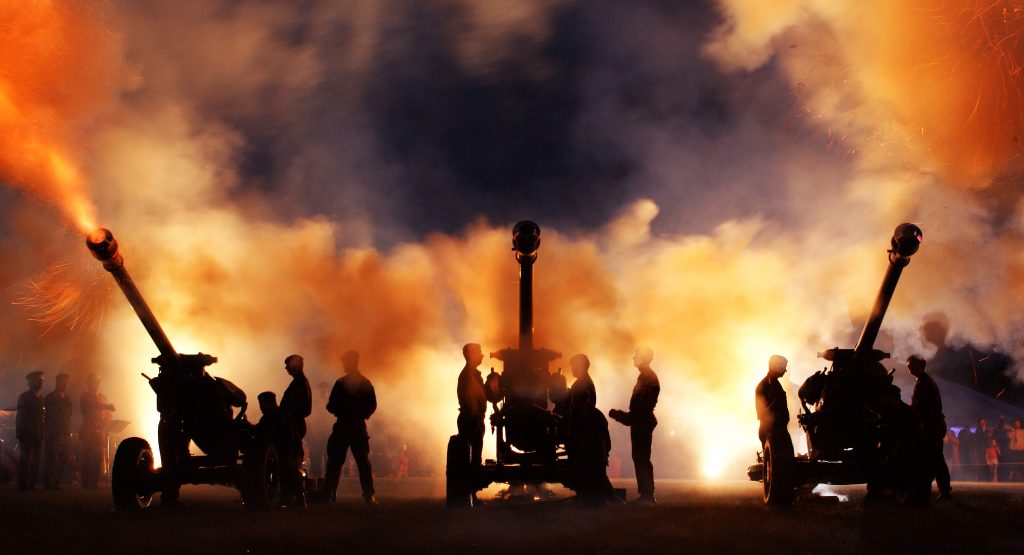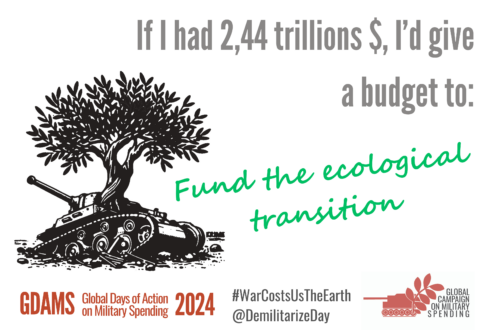Environmental crisis, priorities and military spending
By Pere Brunet, GCOMS Steering Group Member and researcher at Centre Delàs of Peace Studies (Barcelona).
The planet may soon enter a dynamic that could destroy billions of human lives, in addition to many other non-human forms of life. Some estimates speak of more than 100 million climate migrants in 2050 who will be fleeing regions that the environmental crisis will have made uninhabitable.
The situation is very serious, and the 2020 pandemic was just a small warning. According to Hans Joachim Schellnhuber, director of Potsdam Institute for Climate Impact Research, our polluting emissions are leading us into a planetary environmental crisis that may be irreversible. A warming of two degrees could trigger major cascading phenomena (melting of ice, the disappearance of permafrost, methane emissions, desertification, the extinction of many species, radical changes in the bacterial system, more epidemics, etc.), further increasing the temperature as a result of an uncontrollable domino effect that would lead to an average global temperature increase of 4 or 5 degrees. Under these circumstances, says Schellnuber, the world’s population could plummet from the current 7.5 billion to around 1 billion.

The warnings from the scientific world are constant. As Professor Denise Gracía points out, “weapons do not get to the roots and causes of instability” (weak governance, lack of food, unemployment, few resources for education, security threats). Denise García goes on to say that “the power of the military does not make the world more peaceful” [1]. Therefore, “nations should prioritize human security and access to common goods over military spending” [2].
As early as November 1992, some 1700 scientists from around the world, including most of the Nobel laureates who were alive at the thime, warned us. They explained that human activities cause often irreversible damage to the environment and critical resources, that many of our current practices may end up altering the world, and stated that “success in this global effort will require a major reduction in violence and warfare. Resources now devoted to the preparation for and the conduct of war will be needed for these new tasks, and will have to be diverted to the new challenges”.
According to the Global Peace Index, peace levels have fallen by 2,5% since 2008 and military spending is responsible for 40,5% of the economic impact of violence in the world [3]. And where there is violence and insecurity, there can be no human security or prosperity of the people. As Denis García explains, less developed countries with high levels of violence (such as El Salvador, Somalia and Yemen) are the ones who suffer more. And countries with armed conflicts, such as Syria, South Sudan and Afghanistan, lost up to 60% of their GDP in 2019. The old world order, in which governments build arsenals to protect the state, is clearly not delivering what people need.
In this context, Denise Garcia’s August 2020 article in Nature magazine proposes four priorities: stop the arms race (the world is already flooded by weapons), abide by the 2014 arms trade agreement, implement the 2015 Paris Agreement regarding climate, and invest in the Sustainable Development Goals (SDG) of the UN. Denise García goes on to say that “governments must accept that their concept of national security, sustained by a military-industrial complex, is anachronistic and irrelevant”.
Achieving the proposed targets of these goals in 2030 would require an annual expenditure of 5% of the world GDP. On the other hand, the latest data on global military spending indicate that it represents 2.2% of the global GDP, while it varies greatly from country to country: in Saudi Arabia it is 8% of its annual GDP, in Israel it is 5.3%, in Russia it rises to 3.9%, and in the USA it constitutes 3.4% of its annual GDP. Surprisingly, in the U.S. 2021 budget, prepared in the midst of the Covid crisis, the government included 28.9 billion to to modernize its nuclear arsenal, but no budget for combating climate change or pandemics. At the other extreme, New Zealand, with a military spending of 1% of its GDP, has managed the Covid pandemic much better. And Costa Rica, without an army, has this year been one of the first countries to halt and reverse its deforestation, with the goal of becoming a carbon neutral country.
The conclusion, from the evidence and multiple scientific studies, is clear. The old world order, based on military spending, violence and border protection, has not improved human security, but rather worsened it. The environmental crisis requires a radical paradigm shift, reducing military spending and investing in people and in the UN SDG. In this sense, it is essential that both the fight against the environmental crisis and the ecological transition incorporate and demand the reduction of global military expenditure and the transfer of these funds to finance security policies for peace.
[1] Denise Garcia is a professor at Northeastern University in Boston and a consultant to the United Nations. See: Denise García (2020), “Redirect military budgets to climate and pandemics”, Nature, Vol. 584, August 2020: https://www.nature.com/articles/d41586-020-02460-9
[2] Denise García: “Disarmament Diplomacy and Human Security: Regimes, Norms and Moral Progress in International Relations”, (Routledge, 2011).
[3] The index, from the Institute for Economics & Peace, measures 23 indicators (including military spending and ease of access to small arms) in 163 independent states and territories, ranking them according to their level of tranquility and peace: “Global Peace Index 2020: Measuring Peace in a Complex World” (IEP, Institute for Economics & Peace, 2020): https://www.visionofhumanity.org/wp-content/uploads/2020/10/GPI_2020_web.pdf
– See also: “Redirect military budgets to tackle climate change and pandemics”: https://www.visionofhumanity.org/redirect-military-budgets-to-tackle-climate-change-and-pandemics/



